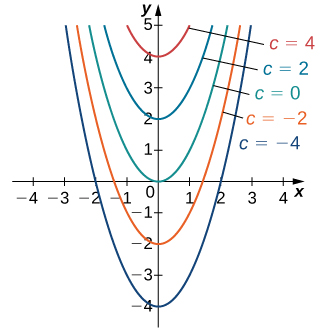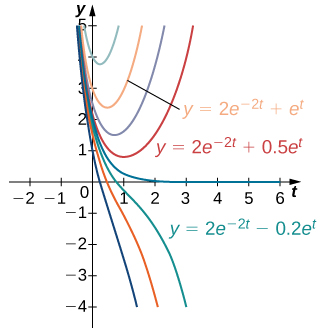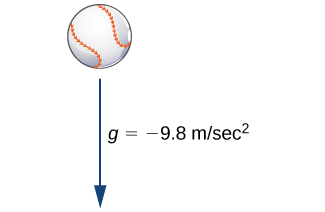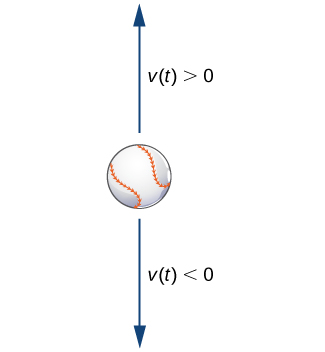
Calculus is the mathematics of change, and rates of change are expressed by derivatives. Thus, one of the most common ways to use calculus is to set up an equation containing an unknown function
and its derivative, known as a differential equation. Solving such equations often provides information about how quantities change and frequently provides insight into how and why the changes occur.
Techniques for solving differential equations can take many different forms, including direct solution, use of graphs, or computer calculations. We introduce the main ideas in this chapter and describe them in a little more detail later in the course. In this section we study what differential equations are, how to verify their solutions, some methods that are used for solving them, and some examples of common and useful equations.
Consider the equation
which is an example of a differential equation because it includes a derivative. There is a relationship between the variables
and
is an unknown function of
Furthermore, the left-hand side of the equation is the derivative of
Therefore we can interpret this equation as follows: Start with some function
and take its derivative. The answer must be equal to
What function has a derivative that is equal to
One such function is
so this function is considered a solution to a differential equation.
A differential equation is an equation involving an unknown function
and one or more of its derivatives. A solution to a differential equation is a function
that satisfies the differential equation when
and its derivatives are substituted into the equation.
Go to this website to explore more on this topic.
Some examples of differential equations and their solutions appear in [link].
| Equation | Solution |
|---|---|
Note that a solution to a differential equation is not necessarily unique, primarily because the derivative of a constant is zero. For example,
is also a solution to the first differential equation in [link]. We will return to this idea a little bit later in this section. For now, let’s focus on what it means for a function to be a solution to a differential equation.
Verify that the function
is a solution to the differential equation
To verify the solution, we first calculate
using the chain rule for derivatives. This gives
Next we substitute
and
into the left-hand side of the differential equation:
The resulting expression can be simplified by first distributing to eliminate the parentheses, giving
Combining like terms leads to the expression
which is equal to the right-hand side of the differential equation. This result verifies that
is a solution of the differential equation.
Verify that
is a solution to the differential equation
First calculate
then substitute both
and
into the left-hand side.
It is convenient to define characteristics of differential equations that make it easier to talk about them and categorize them. The most basic characteristic of a differential equation is its order.
The order of a differential equation is the highest order of any derivative of the unknown function that appears in the equation.
What is the order of each of the following differential equations?
so the order is
so the order is
so the order is
What is the order of the following differential equation?
What is the highest derivative in the equation?
We already noted that the differential equation
has at least two solutions:
and
The only difference between these two solutions is the last term, which is a constant. What if the last term is a different constant? Will this expression still be a solution to the differential equation? In fact, any function of the form
where
represents any constant, is a solution as well. The reason is that the derivative of
is
regardless of the value of
It can be shown that any solution of this differential equation must be of the form
This is an example of a general solution to a differential equation. A graph of some of these solutions is given in [link]. (Note: in this graph we used even integer values for
ranging between
and
In fact, there is no restriction on the value of
it can be an integer or not.)

In this example, we are free to choose any solution we wish; for example,
is a member of the family of solutions to this differential equation. This is called a particular solution to the differential equation. A particular solution can often be uniquely identified if we are given additional information about the problem.
Find the particular solution to the differential equation
passing through the point
Any function of the form
is a solution to this differential equation. To determine the value of
we substitute the values
and
into this equation and solve for
Therefore the particular solution passing through the point
is
Find the particular solution to the differential equation
passing through the point
given that
is a general solution to the differential equation.
First substitute
and
into the equation, then solve for
Usually a given differential equation has an infinite number of solutions, so it is natural to ask which one we want to use. To choose one solution, more information is needed. Some specific information that can be useful is an initial value, which is an ordered pair that is used to find a particular solution.
A differential equation together with one or more initial values is called an initial-value problem. The general rule is that the number of initial values needed for an initial-value problem is equal to the order of the differential equation. For example, if we have the differential equation
then
is an initial value, and when taken together, these equations form an initial-value problem. The differential equation
is second order, so we need two initial values. With initial-value problems of order greater than one, the same value should be used for the independent variable. An example of initial values for this second-order equation would be
and
These two initial values together with the differential equation form an initial-value problem. These problems are so named because often the independent variable in the unknown function is
which represents time. Thus, a value of
represents the beginning of the problem.
Verify that the function
is a solution to the initial-value problem
For a function to satisfy an initial-value problem, it must satisfy both the differential equation and the initial condition. To show that
satisfies the differential equation, we start by calculating
This gives
Next we substitute both
and
into the left-hand side of the differential equation and simplify:
This is equal to the right-hand side of the differential equation, so
solves the differential equation. Next we calculate
This result verifies the initial value. Therefore the given function satisfies the initial-value problem.
Verify that
is a solution to the initial-value problem
First verify that
solves the differential equation. Then check the initial value.
In [link], the initial-value problem consisted of two parts. The first part was the differential equation
and the second part was the initial value
These two equations together formed the initial-value problem.
The same is true in general. An initial-value problem will consists of two parts: the differential equation and the initial condition. The differential equation has a family of solutions, and the initial condition determines the value of
The family of solutions to the differential equation in [link] is given by
This family of solutions is shown in [link], with the particular solution
labeled.

Solve the following initial-value problem:
The first step in solving this initial-value problem is to find a general family of solutions. To do this, we find an antiderivative of both sides of the differential equation
namely,
We are able to integrate both sides because the y term appears by itself. Notice that there are two integration constants:
and
Solving [link] for
gives
Because
and
are both constants,
is also a constant. We can therefore define
which leads to the equation
Next we determine the value of
To do this, we substitute
and
into [link] and solve for
Now we substitute the value
into [link]. The solution to the initial-value problem is
The difference between a general solution and a particular solution is that a general solution involves a family of functions, either explicitly or implicitly defined, of the independent variable. The initial value or values determine which particular solution in the family of solutions satisfies the desired conditions.
Solve the initial-value problem
First take the antiderivative of both sides of the differential equation. Then substitute
and
into the resulting equation and solve for
In physics and engineering applications, we often consider the forces acting upon an object, and use this information to understand the resulting motion that may occur. For example, if we start with an object at Earth’s surface, the primary force acting upon that object is gravity. Physicists and engineers can use this information, along with Newton’s second law of motion (in equation form
where
represents force,
represents mass, and
represents acceleration), to derive an equation that can be solved.

In [link] we assume that the only force acting on a baseball is the force of gravity. This assumption ignores air resistance. (The force due to air resistance is considered in a later discussion.) The acceleration due to gravity at Earth’s surface,
is approximately
We introduce a frame of reference, where Earth’s surface is at a height of 0 meters. Let
represent the velocity of the object in meters per second. If
the ball is rising, and if
the ball is falling ([link]).

Our goal is to solve for the velocity
at any time
To do this, we set up an initial-value problem. Suppose the mass of the ball is
where
is measured in kilograms. We use Newton’s second law, which states that the force acting on an object is equal to its mass times its acceleration
Acceleration is the derivative of velocity, so
Therefore the force acting on the baseball is given by
However, this force must be equal to the force of gravity acting on the object, which (again using Newton’s second law) is given by
since this force acts in a downward direction. Therefore we obtain the equation
which becomes
Dividing both sides of the equation by
gives the equation
Notice that this differential equation remains the same regardless of the mass of the object.
We now need an initial value. Because we are solving for velocity, it makes sense in the context of the problem to assume that we know the initial velocity, or the velocity at time
This is denoted by
A baseball is thrown upward from a height of
meters above Earth’s surface with an initial velocity of
and the only force acting on it is gravity. The ball has a mass of
at Earth’s surface.
of the baseball at time
seconds?
where
The initial condition is
where
Therefore the initial-value problem is
The first step in solving this initial-value problem is to take the antiderivative of both sides of the differential equation. This gives
The next step is to solve for
To do this, substitute
and
Therefore
and the velocity function is given by
seconds, substitute
into
The units of velocity are meters per second. Since the answer is negative, the object is falling at a speed of
Suppose a rock falls from rest from a height of
meters and the only force acting on it is gravity. Find an equation for the velocity
as a function of time, measured in meters per second.
What is the initial velocity of the rock? Use this with the differential equation in [link] to form an initial-value problem, then solve for
A natural question to ask after solving this type of problem is how high the object will be above Earth’s surface at a given point in time. Let
denote the height above Earth’s surface of the object, measured in meters. Because velocity is the derivative of position (in this case height), this assumption gives the equation
An initial value is necessary; in this case the initial height of the object works well. Let the initial height be given by the equation
Together these assumptions give the initial-value problem
If the velocity function is known, then it is possible to solve for the position function as well.
A baseball is thrown upward from a height of
meters above Earth’s surface with an initial velocity of
and the only force acting on it is gravity. The ball has a mass of
kilogram at Earth’s surface.
of the baseball at time
seconds?
The initial height of the baseball is
meters, so
Therefore the initial-value problem for this example is
To solve the initial-value problem, we first find the antiderivatives:
Next we substitute
and solve for
Therefore the position function is
is given by
Therefore the baseball is
meters above Earth’s surface after
seconds. It is worth noting that the mass of the ball cancelled out completely in the process of solving the problem.
and one or more of its derivatives. A solution is a function
that satisfies the differential equation when
and its derivatives are substituted into the equation.
Determine the order of the following differential equations.
Verify that the following functions are solutions to the given differential equation.
solves
solves
solves
solves
solves
solves
solves
solves
solves
solves
Verify the following general solutions and find the particular solution.
Find the particular solution to the differential equation
that passes through
given that
is a general solution.
Find the particular solution to the differential equation
that passes through
given that
is a general solution.
Find the particular solution to the differential equation
that passes through
given that
is a general solution.
Find the particular solution to the differential equation
that passes through
given that
is a general solution.
Find the particular solution to the differential equation
that passes through
given that
is a general solution.
Find the particular solution to the differential equation
that passes through
given that
is a general solution.
Find the particular solution to the differential equation
that passes through
given that
is a general solution.
Find the particular solution to the differential equation
that passes through
given that
is a general solution.
Find the particular solution to the differential equation
that passes through
given that
is a general solution.
Find the particular solution to the differential equation
that passes through
given that
is a general solution.
For the following problems, find the general solution to the differential equation.
Solve the following initial-value problems starting from
and
Draw both solutions on the same graph.
Solve the following initial-value problems starting from
At what time does
increase to
or drop to
never
Recall that a family of solutions includes solutions to a differential equation that differ by a constant. For the following problems, use your calculator to graph a family of solutions to the given differential equation. Use initial conditions from
to
increasing by
Is there some critical point where the behavior of the solution begins to change?
[T]
[T]
Solution changes from increasing to decreasing at
[T]
[T]
(Hint:
is the general solution)
Solution changes from increasing to decreasing at
[T]
Find the general solution to describe the velocity of a ball of mass
that is thrown upward at a rate
ft/sec.
In the preceding problem, if the initial velocity of the ball thrown into the air is
ft/s, write the particular solution to the velocity of the ball. Solve to find the time when the ball hits the ground.
You throw two objects with differing masses
and
upward into the air with the same initial velocity
ft/s. What is the difference in their velocity after
second?
ft/s
[T] You throw a ball of mass
kilogram upward with a velocity of
m/s on Mars, where the force of gravity is
m/s2. Use your calculator to approximate how much longer the ball is in the air on Mars.
[T] For the previous problem, use your calculator to approximate how much higher the ball went on Mars.
meters
[T] A car on the freeway accelerates according to
where
is measured in hours. Set up and solve the differential equation to determine the velocity of the car if it has an initial speed of
mph. After
minutes of driving, what is the driver’s velocity?
[T] For the car in the preceding problem, find the expression for the distance the car has traveled in time
assuming an initial distance of
How long does it take the car to travel
miles? Round your answer to hours and minutes.
hours
minute
[T] For the previous problem, find the total distance traveled in the first hour.
Substitute
into
to find a particular solution.
Substitute
into
to find a particular solution.
Substitute
into
to find a particular solution.
Substitute
into
to find a particular solution.
Solve
with the initial condition
and solve
with the same initial condition. As
approaches
what do you notice?
and
and one or more of its derivatives
that satisfies a given differential equation

You can also download for free at http://cnx.org/contents/9a1df55a-b167-4736-b5ad-15d996704270@5.1
Attribution: